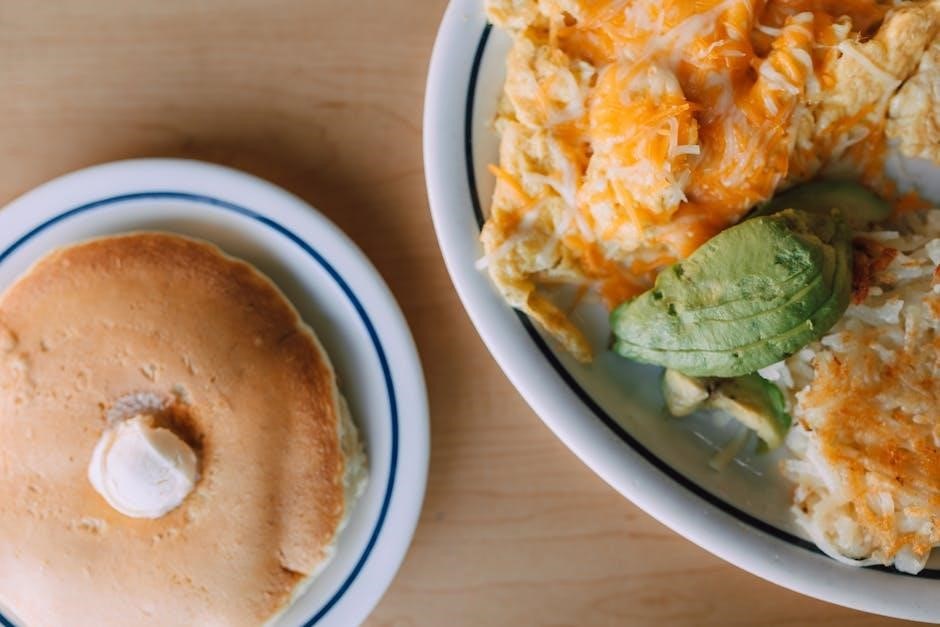90/30/50 Method Meal Plan: An Overview
The 90/30/50 method centers around consuming 90 grams of protein, 30 grams of fiber, and 50 grams of healthy fats daily. This balanced approach aims to support blood sugar balance and promote weight loss.
What is the 90/30/50 Method?
The 90/30/50 method is a dietary approach focusing on specific daily intakes of macronutrients: 90 grams of protein, 30 grams of fiber, and 50 grams of healthy fats. This method aims to create a balanced eating pattern that supports various health goals, including weight management and improved blood sugar control. Unlike rigid diet plans, the 90/30/50 method offers flexibility, allowing individuals to choose foods they enjoy while meeting the specified macronutrient targets.
The core principle involves prioritizing protein, fiber, and healthy fats in each meal and snack. This emphasis encourages the consumption of nutrient-dense foods over processed options. The method can be integrated into various dietary preferences and lifestyles. However, individual needs may vary, so consulting with a healthcare professional or registered dietitian is recommended before adopting this approach. The 90/30/50 method serves as a guideline rather than a strict rule, promoting mindful eating and a balanced dietary intake.

Understanding the Macronutrient Ratios
The 90/30/50 method prioritizes macronutrient balance, emphasizing protein, fiber, and healthy fats. Understanding these ratios is crucial for successfully implementing the plan and achieving its intended benefits for health and well-being.
90 Grams of Protein: Sources and Benefits
Consuming 90 grams of protein daily is a cornerstone of the 90/30/50 method, offering significant benefits. Protein is crucial for muscle repair, growth, and overall satiety, helping to manage appetite and support weight loss. Incorporating lean protein into every meal is key, with options like chicken, fish, eggs, and tofu being excellent choices.
Diversifying protein sources is also important to ensure a range of amino acids and nutrients. Legumes and plant-based alternatives offer additional protein options, catering to various dietary preferences. Meeting the 90-gram target can help stabilize blood sugar levels and promote a feeling of fullness, reducing the likelihood of overeating.
Furthermore, adequate protein intake supports metabolic function and energy levels throughout the day. By strategically including protein in each meal, individuals can optimize the benefits of the 90/30/50 method and achieve their health and fitness goals. Remember to adjust portion sizes based on individual needs.
30 Grams of Fiber: Importance and Food Choices
Fiber plays a vital role in the 90/30/50 method, promoting digestive health and overall well-being. Consuming 30 grams of fiber daily aids in regulating blood sugar levels, preventing spikes and crashes that can lead to cravings and energy dips. High-fiber foods also contribute to increased satiety, helping to manage appetite and support weight management efforts.
Incorporating a variety of fiber-rich foods into your diet is essential to meet the daily target. Whole grains, legumes, vegetables, and fruits are excellent sources of fiber, offering a range of nutrients and health benefits. Almonds and chickpeas can be good additions, contributing to the overall fiber intake.
Focusing on including fiber with each meal and snack can help ensure consistent intake throughout the day. This consistent intake supports healthy digestion, prevents constipation, and promotes a feeling of fullness. By prioritizing fiber-rich foods, individuals can optimize the benefits of the 90/30/50 method and achieve improved health outcomes.
50 Grams of Healthy Fats: Types and Roles
Incorporating 50 grams of healthy fats into the 90/30/50 method is crucial for overall health and well-being. Healthy fats play a vital role in hormone production, cell function, and nutrient absorption. They also provide sustained energy, helping to keep you feeling full and satisfied throughout the day.
There are different types of healthy fats, each with its own unique benefits. Monounsaturated fats, found in olive oil, avocados, and nuts, are known for their heart-healthy properties. Polyunsaturated fats, including omega-3 and omega-6 fatty acids, are essential for brain function and reducing inflammation.
Sources of healthy fats include avocados, nuts, seeds, and olive oil. These options can be incorporated into meals and snacks to help meet the daily target of 50 grams. It’s important to choose healthy fats in moderation, as they are calorie-dense. By prioritizing healthy fats, you can support your overall health and optimize the benefits of the 90/30/50 method.

Sample 90/30/50 Meal Plan
This sample meal plan demonstrates how to incorporate 90 grams of protein, 30 grams of fiber, and 50 grams of healthy fats into your daily diet. Feel free to adjust it based on your preferences.
Breakfast Ideas
Start your day right with a protein and fiber-packed breakfast. One option is an oatmeal bowl prepared with protein powder and topped with nuts and seeds for healthy fats. Alternatively, try a piece of wheat toast with avocado and an egg, offering a balanced combination of macronutrients.
Another great choice is a Greek yogurt parfait. Layer Greek yogurt with berries and a sprinkle of nuts for added fiber and healthy fats. Ensure your breakfast contains at least 20-30 grams of protein to keep you feeling full and satisfied.
Consider adding chia seeds or flaxseeds to your oatmeal or yogurt for an extra boost of fiber and omega-3 fatty acids. Experiment with different combinations to find what you enjoy most, while adhering to the 90/30/50 principles for optimal results. Remember to drink plenty of water.
Lunch Ideas
For lunch, focus on lean protein and fiber-rich foods to keep you energized throughout the afternoon. A grilled chicken salad is an excellent option, incorporating mixed greens, various colorful vegetables, and a light vinaigrette dressing. You can add chickpeas or black beans for extra fiber.
Another great choice is a hearty lentil soup with a side of whole-grain bread. Lentils are packed with protein and fiber, making them a satisfying and nutritious option. Consider adding a source of healthy fats, such as avocado slices, to complete the meal.
Alternatively, prepare a protein-packed quinoa bowl with roasted vegetables and a lean protein source like tofu or fish. Be sure to include plenty of non-starchy vegetables to increase your fiber intake and keep you feeling full and satisfied until dinner. Remember, variety is key!
Dinner Ideas
Dinner is an excellent opportunity to incorporate a substantial portion of your daily protein and fiber. Baked salmon with quinoa and steamed broccoli is a fantastic choice, providing omega-3 fatty acids, complex carbohydrates, and essential vitamins. Ensure the salmon portion is adequate to meet your protein goals.
Another delicious option is a lean ground turkey stir-fry with plenty of colorful vegetables like bell peppers, onions, and snap peas. Use a low-sodium sauce and serve it over brown rice or quinoa for a complete and balanced meal. Add nuts.
Consider a hearty chickpea curry with spinach and a side of whole-wheat naan. Chickpeas are an excellent source of plant-based protein and fiber. Remember to stay hydrated by drinking plenty of water throughout the day and with your meals.
Benefits and Drawbacks of the 90/30/50 Diet
The 90/30/50 diet offers several potential benefits. It promotes a balanced intake of macronutrients, potentially leading to improved blood sugar control and weight management. The emphasis on protein and fiber can enhance satiety, reducing overall calorie intake. The inclusion of healthy fats supports hormone production and overall well-being. This method provides a structured framework for individuals new to meal planning.
However, the diet also has potential drawbacks. It may not be suitable for everyone, as individual needs vary based on activity level, body size, and health conditions. The fixed macronutrient ratios may not be ideal for those with specific dietary requirements. Tracking macros can be time-consuming. This approach is more of a rule of thumb than a plan.

Tips for Implementing the 90/30/50 Method
To successfully implement the 90/30/50 method, start by diversifying your protein sources, incorporating lean meats, fish, eggs, and plant-based alternatives. Focus on high-fiber foods like whole grains, legumes, and vegetables. Choose healthy fats in moderation, such as olive oil, avocado, nuts, and seeds. Use apps to track your food intake and macronutrient content.
Plan your meals in advance, creating a weekly menu that aligns with the diet’s guidelines. Add lean protein to every meal. If your goal is to eat breakfast every morning, come up with a high-protein, high-fiber meal. Drink plenty of water throughout the day. Remember to adjust meal plans based on your preferences and dietary needs.

Who is the 90/30/50 Method Suitable For?
The 90/30/50 method is suitable for individuals seeking a structured approach to balanced nutrition, especially those aiming for weight loss or improved blood sugar control. It provides a clear framework for macronutrient intake, making it easier to understand and follow. However, it’s crucial to consider individual needs and activity levels, adjusting the plan accordingly.
It’s essential to note that the 90/30/50 method may not be appropriate for everyone. Individuals with a history of eating disorders should approach this method with caution, seeking guidance from a healthcare provider or registered dietitian. This plan is more of a rule of thumb than an individualized plan.



